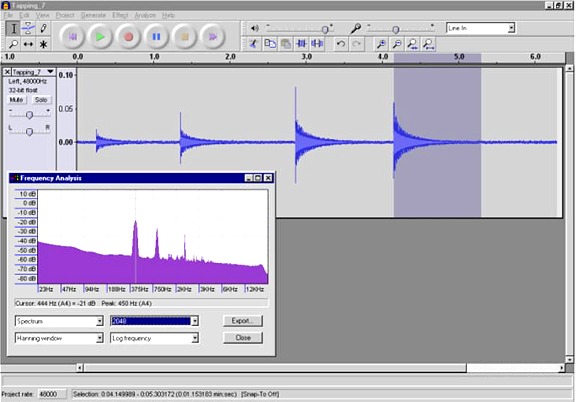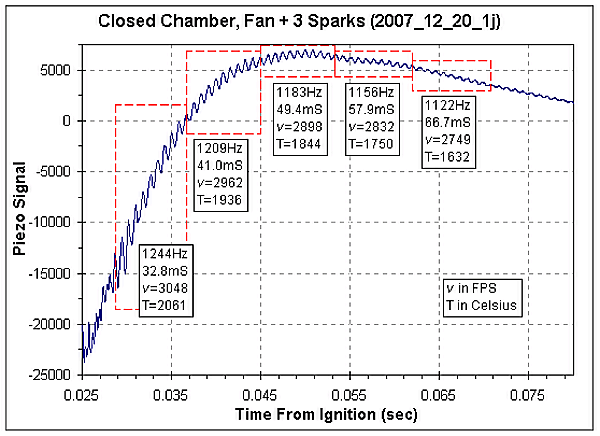Temperature in a closed combustion chamber
Posted: Wed Jan 23, 2008 5:44 pm
So, continuing on with interesting things that can be learned from the closed combustion chamber...
Looking at the piezo trace I see a high frequency signal superimposed on the much lower pressure (or dP/dt) signal.
In the past, I've made PVC flutes and whistles. The air in a pipe closed at both ends resonates at predictable frequencies given by;
f = nv / 2L (eq. 1)
Where;
f is the frequency
n is an integer (1 = fundamental, >1 for overtones)
v is the speed of sound
L is the length of the pipe.
As folks who follow these forums know, the speed of sound in a gas is a function of the temperature of the gas. The hotter the gas the faster the speed of sound.
Questions: Is the high frequency signal the piezo transducer records related to the resonant frequency of the chamber? If it is, can we calculate the temperature in the chamber from the resonant frequency?
So, I recorded the signal the piezo transducer generates of tapping on the chamber with a hammer. The figure below is a scrreen shot of the recording in Audacity. The insert graph is the spectrum (frequency) analysis of the highlighted region.

The chamber was pressurized to ~100 PSIG since it resonates much better when pressurized. The chamber resonates at 450Hz. (The unpressurized chamber resonates at about 440Hz but the signal is weak.) Here is what the piexo transducer recorded when I tapped on the chamber pressurized with air.
My "lab" was 45F when this recording was made. The speed of sound at 45F is 1101.5FPS. Using equation 1 we can calculate the "accoustic length" of the chamber as 1.224 feet (14.7 inch).
I then used GasEq to calculate the speed of sound as a function of temperature (GasEq calculates all kinds of useful things besides temperature and pressure) in the propane + air combustion products. GasEq gives a peak temperature of 2358C for a starting temperature of 10C (the temp when the combustion recordings were made). The equation is;
Tc = (-6.497x10-8 )v<sub>sound</sub><sup>3</sup> + (6.886x10-4)v<sub>sound</sub><sup>2</sup> - (0.9200)v<sub>sound</sub> + 3076, R2 = 1.000 (eq. 2)
Where;
Tc is the gas temperature in degrees celsius
v<sub>sound</sub> is the speed of sound in FPS.
Equation 2 allows us to calulate the temperature of the gases from the speed of sound in the gases.
So we should be able to calculate the temperature of the gases in the chamber using equations 1 and 2 if we measure the resonant frequency of the chamber.
I measured the frequency within the 10 cycle windows.
The graph below shows a region of the piezo transducer recording. The left side of the graph corresponds to the maximum piezo signal. The 10 cycle boxes are outlined in red. The values for each box are the observed frequency, the time to the center of the box, the calculated speed of sound (v) in FPS and the calculated temperature in degrees Celsius. In the vicinity of the peak piezo signal the signal is too complex to measure the frequency, the earliest frequency I could measure was at 32.8mS, about 13mS after the peak piezo signal.

According to GasEq, the peak temperature for the combustion of propane in air with a starting temperature of 10C is 2358C. The maximum observed temperature was 2061C.
The temperature appears to drop very quickly. For the five measurements shown in the graph above the temperature appears to drop 429C in just 34 milliseconds. Based on the time and temperature drop we can estimate a thermal half-life of this chamber of about 81mS. So, for every 81mS the temperature drops by a factor of two.
Since the energy in the chamber is proportional to the temperature of the gases, the energy in the chamber drops at the same rate. Within a few tenths of a second after ignition virtually all of the energy in the chamber has been lost as heat transferred to the chamber walls.
This is probably why it is not possible to make a combustion or hybrid gun using any kind of a valve setup that requires the operator to trigger the valve. By the time the valve is triggered virtually all the energy in the chamber has been lost.
For more details see http://www.inpharmix.com/jps/Chamber_Temperature.html
EDIT: Fixed link url
Looking at the piezo trace I see a high frequency signal superimposed on the much lower pressure (or dP/dt) signal.
In the past, I've made PVC flutes and whistles. The air in a pipe closed at both ends resonates at predictable frequencies given by;
f = nv / 2L (eq. 1)
Where;
f is the frequency
n is an integer (1 = fundamental, >1 for overtones)
v is the speed of sound
L is the length of the pipe.
As folks who follow these forums know, the speed of sound in a gas is a function of the temperature of the gas. The hotter the gas the faster the speed of sound.
Questions: Is the high frequency signal the piezo transducer records related to the resonant frequency of the chamber? If it is, can we calculate the temperature in the chamber from the resonant frequency?
So, I recorded the signal the piezo transducer generates of tapping on the chamber with a hammer. The figure below is a scrreen shot of the recording in Audacity. The insert graph is the spectrum (frequency) analysis of the highlighted region.

The chamber was pressurized to ~100 PSIG since it resonates much better when pressurized. The chamber resonates at 450Hz. (The unpressurized chamber resonates at about 440Hz but the signal is weak.) Here is what the piexo transducer recorded when I tapped on the chamber pressurized with air.
My "lab" was 45F when this recording was made. The speed of sound at 45F is 1101.5FPS. Using equation 1 we can calculate the "accoustic length" of the chamber as 1.224 feet (14.7 inch).
I then used GasEq to calculate the speed of sound as a function of temperature (GasEq calculates all kinds of useful things besides temperature and pressure) in the propane + air combustion products. GasEq gives a peak temperature of 2358C for a starting temperature of 10C (the temp when the combustion recordings were made). The equation is;
Tc = (-6.497x10-8 )v<sub>sound</sub><sup>3</sup> + (6.886x10-4)v<sub>sound</sub><sup>2</sup> - (0.9200)v<sub>sound</sub> + 3076, R2 = 1.000 (eq. 2)
Where;
Tc is the gas temperature in degrees celsius
v<sub>sound</sub> is the speed of sound in FPS.
Equation 2 allows us to calulate the temperature of the gases from the speed of sound in the gases.
So we should be able to calculate the temperature of the gases in the chamber using equations 1 and 2 if we measure the resonant frequency of the chamber.
I measured the frequency within the 10 cycle windows.
The graph below shows a region of the piezo transducer recording. The left side of the graph corresponds to the maximum piezo signal. The 10 cycle boxes are outlined in red. The values for each box are the observed frequency, the time to the center of the box, the calculated speed of sound (v) in FPS and the calculated temperature in degrees Celsius. In the vicinity of the peak piezo signal the signal is too complex to measure the frequency, the earliest frequency I could measure was at 32.8mS, about 13mS after the peak piezo signal.

According to GasEq, the peak temperature for the combustion of propane in air with a starting temperature of 10C is 2358C. The maximum observed temperature was 2061C.
The temperature appears to drop very quickly. For the five measurements shown in the graph above the temperature appears to drop 429C in just 34 milliseconds. Based on the time and temperature drop we can estimate a thermal half-life of this chamber of about 81mS. So, for every 81mS the temperature drops by a factor of two.
Since the energy in the chamber is proportional to the temperature of the gases, the energy in the chamber drops at the same rate. Within a few tenths of a second after ignition virtually all of the energy in the chamber has been lost as heat transferred to the chamber walls.
This is probably why it is not possible to make a combustion or hybrid gun using any kind of a valve setup that requires the operator to trigger the valve. By the time the valve is triggered virtually all the energy in the chamber has been lost.
For more details see http://www.inpharmix.com/jps/Chamber_Temperature.html
EDIT: Fixed link url